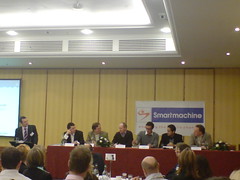MobileYouth: Marketing to youth: how do we engage consumers?
Panel session 1: "Marketing to youth: how do we engage consumers?"
Richard Sandford, Marketing Manager, Nokia
John Baker, Head of Interactive, OgilvyOne
Rhys MacLachlan, Head of Broadcast Implementation, MediaComUK
Tom Johnstone, Senior Planner, AMV BBDO
Dusan Hamlin, CEO, Inside
Richard Marshall, CEO Rapid Mobile
GB: "Entrepeneurialism is the last resort of the troublemaker".
GB: The major form of engaging young people was TV, but this is changing. In the 60s/70s, youth were exposed to about 70 ads a day compared to shy of 120/day now. But the recall rate has halved in spite of this. What's going on here?
RM: A degree of overexposure; people are blasé about it. Kids know how to read media in a way we didn't when we were young; they can spot condescension and people trying to be "cool". They're cynical consumers with more disposable income than previous generations.
GB: Is this a global trend?
DH: Yes. Youth have so many more ways to express individuality right now (reminds me of quote from an article from Adbusters: "millions of people expressing their individuality in the same way").
Comment from a kid in a MobileYouth video on SMS marketing: "You get all happy thinking someone loves you, and they just want you to buy something". Internet advertising is "quite annoying".
GB: Children aren't jumping into advertising.
TJ: "Youth" is a deceptive term; young people are increasingly segmented. Channel 4 research split youth 14-19 into 17 different tribes, shoehorning these into a single bracket doesn't work. e.g. indie kids explicitly don't want flashy phones, they want something with a camera to upload to Flickr/YouTube. I did some work with youth in Moss-Side recently, their favourite ads were the Marks & Spencers food porn ones, because they didn't feel they were being sold to - and they were hungry :)
RMcL: It needs to be personalised and relevant (yawn). We need to do an ROI model - Return On Interest. (How is this in any way interesting thinking - surely we should take this stuff for granted nowadays?).
GB: As an industry we're approached mobile from a reach perspective. Look at Jones Soda, which does a turkey and gravy flavour at Xmas. "We own the meat flavoured drink market", they say :) Their customers send in photos and they put these photos onto the bottles: the customers own the product, they think... and product development and marketing are integrated to the point where they might be the same thing. Is there a risk that young people will hijack the brand?
JB: 2 teen magazines have stopped printing in the US in the last year, which indicates a shift away from traditional media and towards different ways of youth communication. You can be the court jester (funny), courtesan (sexy) or courtier (being really seriously useful) in marketing to youth.
RMcL: If you give one mother a good experience, she'll talk about it. We can't control word of mouth (yawn).
JB: The phone used to be a shared resource. Nowadays everyone owns one and communicates lots of different ways (yawn).
Question from audience: would teenagers be more receptive to advertising if they were paid to view it (with free texts or airtime).
RMcL: Yes, this is a "Return on Interest".
RM: Watching adverts is part of the bargain for TV viewers. SMS marketing is like "chugging": unwelcome and ineffective, but gets through to some people. Making it useful is part of the key.
